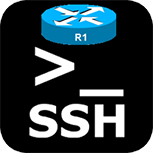 This article shows how to configure and setup SSH for remote management of Cisco IOS Routers. We’ll show you how to check if SSH is supported by your IOS version, how to enable it, generate an RSA key for your router and finally configure SSH as the preferred management protocol under the VTY interfaces.
This article shows how to configure and setup SSH for remote management of Cisco IOS Routers. We’ll show you how to check if SSH is supported by your IOS version, how to enable it, generate an RSA key for your router and finally configure SSH as the preferred management protocol under the VTY interfaces.
Secure Shell (SSH) provides a secure and reliable mean of connecting to remote devices. It’s an encrypted network protocol that allows users to safely access equipment via command line interface sessions. SSH makes use of TCP port 22 which’s assigned to secure logins, file transfer and port forwarding.
SSH uses public key for authenticating the remote device and encrypt all data between that device and the workstation which makes it the best choice for public networks, unlike (telnet) which transmits data in plain text which subjects it to security threats, this makes (telnet) recommended for private networks only to keep the data uncompromised.
Verifying SSH Support on your Router
The first step involves examining whether your Cisco router’s IOS supports SSH or not. Most modern Cisco routers support SSH, so this shouldn’t be a problem.
Products with (K9) in the image name e.g c2900-universalk9-mz.SPA.154-3.M2.bin, support strong encryption with 3DES/AES while (K8) IOS bundles support weak encryption with the outdated DES.
To check, simply enter privilege mode and use the show ip ssh command:
R1# show ip ssh
SSH Disabled - version 1.99
%Please create RSA keys to enable SSH (and of atleast 768 bits for SSH v2).
Authentication timeout: 120 secs; Authentication retries: 3
Minimum expected Diffie Hellman key size : 1024 bits
IOS Keys in SECSH format(ssh-rsa, base64 encoded): NONE
In the above output, the system is showing SSH support, but it’s currently disabled as no RSA key has been generated. It is also worth noting that a key of at least 768 bits must be generated to enable SSHv2.
Securing Access to Router
It’s always a good idea to first restrict access to the Cisco router before enabling SSH. This is very important especially when the device has an interface facing public networks e.g Internet, Public Hotspot.
We first create user credentials for the device and then enable Athentication, Authorization & Accounting Services (AAA). Finally, ensure a secret password is set to protect access to privilege mode, along with the service password-encryption command to ensure all clear-text passwords are encrypted:
Router (config)# aaa new-model
Router (config)# aaa authentication login default local
Router (config)# enable secret $FirewAll.cx!
Router (config)# service password-encryption
Next, it is highly recommended to restrict remote access via the SSH protocol only. This will ensure that insecure services such as Telnet cannot be used to access the router. Telnet sends all information unencrypted, including username/password, and is therefore considered a security risk.
We’ll use the transport input ssh command under the VTY section to restrict remote access using SSH only. Note that we can also use Access-lists to restrict SSH connections to our router:
R1(config-line)# transport input ssh
R1(config-line)# login authentication default
R1(config-line)# password $Cisco!
Note: the password command used under line vty 0 4 section is completely optional and not used in our case because of the login authentication default command which forces the router to use the AAA mechanism for all user authentication.